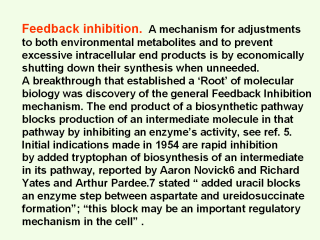| front |1 |2 |3 |4 |5 |6 |7 |8 |9 |10 |11 |12 |13 |14 |15 |16 |17 |18 |19 |20 |21 |22 |23 |24 |25 |26 |27 |28 |29 |30 |review |
 |
Convincing
demonstrations that an end-product can inhibit the initial enzymatic
reaction was identified for pathways synthesizing isoleucine-valine 8 by
Edwin Umbarger in 1956, and for pyrimidines by Yates and Pardee where the
first enzyme in the seven successive enzyme-catalyzed reactions (aspartate
transcarbamylase, ATCase) is feedback inhibited by added uracil.9 As expected mutant bacteria could accumulate the metabolite prior to their missing reaction, but only when the end product of the pathway was not provided. This observation led to perhaps the first review on regulation of metabolism.10 Feedback mechanisms have now been verified for numerous pathways.11 Some of these are complex, involving metabolic branching as investigated by Earl Stadtman.12 A remarkable example is ribonucleotide reductase, whose feedback regulation Peter Reichard demonstrated balances production of the four deoxynucleotide building blocks of DNA from alternative substrates.13 |